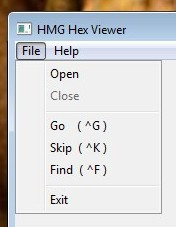Fill arrays with the structure of the current database file
AFIELDS([<aFieldNames>],
[<aTypes>],
[<aWidths>],
[<aDecimals>]) --> nFields
Return a specified work area alias
ALIAS([<nWorkArea>]) --> cAlias
Determine when beginning of file is encountered
BOF() --> lBoundary
Add a new record
DBAPPEND() --> NIL
Clear a filter condition
DBCLEARFILTER() –> NIL
DBCLEARIND() : Close all indexes for the current work area
DBCLEARINDEX() --> NIL
DBCLEARREL() :
Clear active relations
DBCLEARRELATION() --> NIL
Close all occupied workareas
DBCLOSEALL() --> NIL
Close a workarea
DBCLOSEAREA() --> NIL
Flush pending updates
DBCOMMIT() --> NIL
Flush pending updates in all workareas
DBCOMMITALL() --> NIL
Create a database file from a database structure array
DBCREATE(<cDatabase>, <aStruct> [, <cDriver> ] ) --> NIL
Create an Index
DBCREATEINDEX(<cIndexName>, <cKeyExpr>,
[<bKeyExpr>], [<lUnique>]) --> NIL
Mark a record for deletion
DBDELETE() --> NIL
Browse records in a table layout
DBEDIT([<nTop>], [<nLeft>],
[<nBottom>], <nRight>],
[<acColumns>],
[<cUserFunction>],
[<acColumnSayPictures> | <cColumnSayPicture>],
[<acColumnHeaders> | <cColumnHeader>],
[<acHeadingSeparators> | <cHeadingSeparator>],
[<acColumnSeparators> | <cColumnSeparator>],
[<acFootingSeparators> | <cFootingSeparator>],
[<acColumnFootings> | <cColumnFooting>]) --> NIL
Evaluate a code block for each record
DBEVAL(<bBlock>,
[<bForCondition>],
[<bWhileCondition>],
[<nNextRecords>],
[<nRecord>],
[<lRest>]) --> NIL
Return current alias name
DBF() --> cAlias
Return and optionally change information about a field
DBFIELDINFO(<nInfoType>,
<nFieldPos>,
[<expNewSetting>]) --> uCurrentSetting
Insert the contents of a field into a file
DBFILEGET(<nFieldPos>, <cTargetFile>, <nMode>)
--> lSuccess
Insert the contents of a file into a field
DBFILEPUT(<nFieldPos>, <cSourceFile>)
--> lSuccess
DBFILTER() :
Return the current filter expression as a character string
DBFILTER() --> cFilter
Move to the last logical record
DBGOBOTTOM() --> NIL
Move to a particular record
DBGOTO(<nRecordNumber>) --> NIL
Move to the first logical record
DBGOTOP() --> NIL
Return and optionally change database file information
DBINFO(<nInfoType>, [<expNewSetting>])
--> uCurrentSetting
DBORDERINFO() : Return and optionally change information about orders and index files
DBORDERINFO(<nInfoType>, [<cIndexFile>],
[<cOrder> | <nPosition>],
[<expNewSetting>]) --> uCurrentSetting
DBRECALL() :
Reinstate a record marked for deletion
DBRECALL() --> NIL
Return and optionally change information about a record
DBRECORDINFO(<nInfoType>,
[<nRecord>],
[<expNewSetting>]) --> uCurrentSetting
Recreate all active indexes for the current work area
DBREINDEX() --> NIL
Return the linking expression of a specified relation
DBRELATION( <nRelation> ) --> cLinkExp
Lock the record at the current or specified identity
DBRLOCK([<xIdentity>]) --> lSuccess
DBRLOCKLIST() Return an array of the current lock list
DBRLOCKLIST() --> aRecordLocks
Return the target workarea number of a relation
DBRSELECT( <nRelation> ) --> nWorkArea
Release all or specified record locks
DBRUNLOCK([<xIdentity>]) --> NIL
Search for a key value
DBSEEK(<expKey>, [<lSoftSeek>]) --> lFound
Change the current workarea
DBSELECTAREA(<nArea> | <cAlias>) --> NIL
Set the default database driver
DBSETDRIVER([<cDriver>]) --> cCurrentDriver
Set a filter condition
DBSETFILTER(<bCondition>, [<cCondition>]) --> NIL
Empty orders from an order bag into the order list
DBSETINDEX(<cOrderBagName>) --> NIL
Set the controlling order
DBSETORDER(<nOrderNum>) --> NIL
Relate two workareas
DBSETRELATION( <nArea> | <cAlias>, <bExpr>, [<cExpr>]) --> NIL
Move relative to the current record
DBSKIP([<nRecords>]) --> NIL
Create an array containing the structure of a database file
DBSTRUCT() --> aStruct
Release all locks for the current work area
DBUNLOCK() --> NIL
Release all locks for all work areas
DBUNLOCKALL() --> NIL
Use a database file in a workarea
DBUSEAREA( [<lNewArea>],
[<cDriver>],
<cName>,
[<xcAlias>],
[<lShared>],
[<lReadonly>]) --> NIL
Return the deleted status of the current record
DELETED() --> lDeleted
Determine when end of file is encountered
EOF() --> lBoundary
Return the number of fields in the current (.dbf) file
FCOUNT() --> nFields
Return a field name from the current (.dbf) file
FIELD/FIELD(<nPosition>) --> cFieldName
FIELDBLOCK() :
Return a set-get code block for a field variable
FIELDBLOCK(<cFieldName>) --> bFieldBlock
Retrieve the value of a field using the ordinal position of the field in the database structure
FIELDGET(<nField>) --> ValueField
Return a field name from the current (.dbf) file
FIELDNAME/FIELD(<nPosition>) --> cFieldName
Return the position of a field in a workarea
FIELDPOS(<cFieldName>) --> nFieldPos
Set the value of a field variable using the ordinal position of the field in the database structure
FIELDPUT(<nField>, <expAssign>) --> ValueAssigned
Return a set-get block for a field in a given workarea
FIELDWBLOCK(<cFieldName>, <nWorkArea>) --> bFieldWBlock
Lock an open and shared database file
FLOCK() –> lSuccess
Determine if the previous search operation succeeded
FOUND() --> lSuccess
Return the current database file header length
HEADER() --> nBytes
Determine the number of records in the current (.dbf) file
LASTREC() | RECCOUNT()* --> nRecords
Return the last modification date of a (.dbf) file
LUPDATE() --> dModification
Determine the number of records in the current (.dbf) file
RECCOUNT()* | LASTREC() --> nRecords
Return the current record number of a work area
RECNO() --> nRecord
Determine the record length of a database (.dbf) file
RECSIZE() --> nBytes
Lock the current record in the active work area
RLOCK() --> lSuccess
Determine the work area number of a specified alias
SELECT([<cAlias>]) --> nWorkArea
Determine if a database file is in USE
USED() --> lDbfOpen

